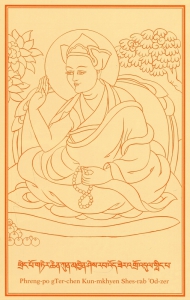ISYT Conference: Religious Figures, Doctrines and Practices
ISYT Conference Day 2
Room Dussane, École Normale Supérieure.
Seiji Kumagai (Kyoto University, Japan)
“Development of the Two Truths Theory in Tibet”
Marc-Henri Deroche (École Pratique des Hautes Études, Paris, France And Kyoto University, Japan)
“Study of The Lamp Illuminating the Two Truths written by ’Phreng po gter ston Shes rab ’od zer (1518-1584)”
 The second morning of the conference began with two friends and colleagues presenting issues related to one of the most important problems of Buddhism, the two truths. Seiji Kumagai of Kyoto circumscribed the history of the development of the two truths theory in Indian Buddhist, Bön, and Tibetan Buddhist philosophy. His handout and presentation was a wealth of information succinctly presented in outline-style. I had never learned anything about the Bön tradition’s conception of the two truths, which appears to be suspiciously (or not so) close to Buddhist presentations.
The second morning of the conference began with two friends and colleagues presenting issues related to one of the most important problems of Buddhism, the two truths. Seiji Kumagai of Kyoto circumscribed the history of the development of the two truths theory in Indian Buddhist, Bön, and Tibetan Buddhist philosophy. His handout and presentation was a wealth of information succinctly presented in outline-style. I had never learned anything about the Bön tradition’s conception of the two truths, which appears to be suspiciously (or not so) close to Buddhist presentations.
In terms of the Tibetan Buddhist interpretations, Kumagai focused on a set of grub mtha’ treatises representing several schools, including: Rong zom Chos kyi bzang po (early 11th cen. rNying ma pa), Rog gi Ban sde Shes rab ‘od (1166-1244 rNying ma pa), the gZhung lugs legs bshad (anonymous from 13th-14th cen.), dBu pa blo gsal (early 14th cen.), Klong chen pa (1308-1363, rnying ma pa), Se ra rJe btsun pa (1469-1546, dGe lugs pa) and finally lCang skya (1717-1786, dGe lugs pa) . This means that Kumagai surveyed treatises from the 11th to 18th centuries detailing the presentation of the two truths in each of the four schools for each text used. He also presented a short discussion of Rong ston’s critique of Tsong kha pa’s presentation of the two truths, along with mKhas ‘grub rje’s response. It is quite obvious that his dissertation will far exceed previous work in the area of describing two truths in Tibetan Buddhism in both quality and quantity.
Marc-Henri Deroche then presented his study and translation of a very interesting text by ’Phreng po gter ston Shes rab ’od zer (1518-1584). This Buddhist master trained first in sa skaya tradition, then attained the geshe degree at a dge lugs monastery, and trained in bka’ brgyud and rnying ma practices for the rest of his life. He was also a gter ston and later established a rnying ma monastery and was recognized as an emanation of Vairocana. Deroche spoke of the two truths as a universal problem of philosophy and impressed upon the audience the importance of Shes rab ‘od zer’s “Rime” approach. The text is an account of the two truths in Madhyamaka that references texts only from masters prior to the 11th century. Although trained deeply in the dge lugs approach, no mention is made of Tsong kha pa. The focus is more on Nagarjuna, Atisha, and ‘brom ston pa. Deroche sees it as a text oriented towards yogic practice and sees the author as a uniquely important progenitor of the Rime movement.
Please note that if anyone wants more clarification on anything, contact information for presenters, or any other information, just leave me a note: Marcus@tsadra.org

